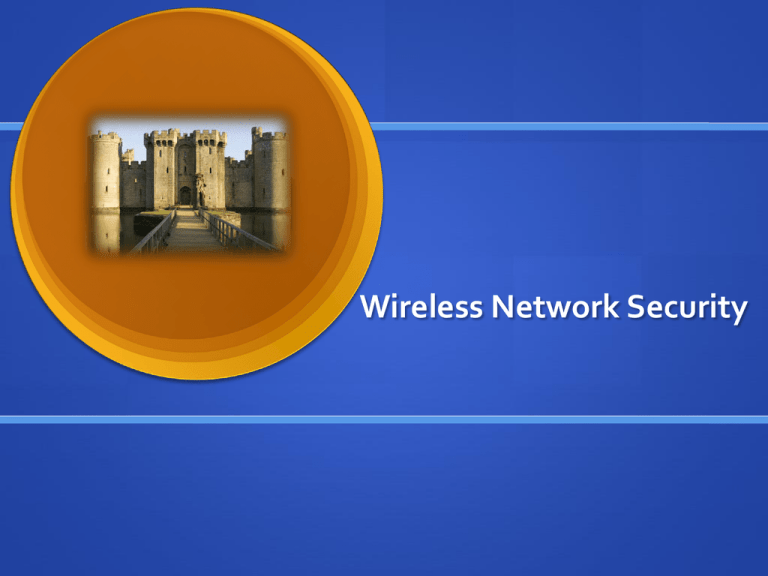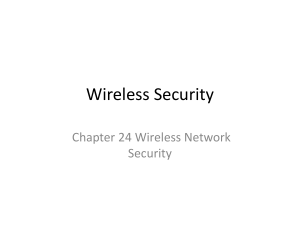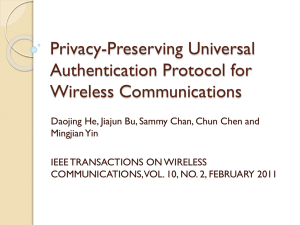Slides
advertisement

Wireless Network Security Wireless Security Overview concerns for wireless security are similar to those found in a wired environment security requirements are the same: confidentiality, integrity, availability, authenticity, accountability most significant source of risk is the underlying communications medium Wireless Networking Components Endpoint Access point Figure 24.1 Wireless Networking Components Wireless Network Threats accidental association malicious association ad hoc networks nontraditional networks identity theft (MAC spoofing) man-in-the middle attacks denial of service (DoS) network injection Securing Wireless Transmissions principal threats are eavesdropping, altering or inserting messages, and disruption countermeasures for eavesdropping: signal-hiding techniques encryption the use of encryption and authentication protocols is the standard method of countering attempts to alter or insert transmissions Securing Wireless Networks the main threat involving wireless access points is unauthorized access to the network principal approach for preventing such access is the IEEE 802.1X standard for port-based network access control the standard provides an authentication mechanism for devices wishing to attach to a LAN or wireless network use of 802.1X can prevent rogue access points and other unauthorized devices from becoming insecure backdoors Wireless Network Security Techniques use encryption allow only specific computers to access your wireless network use anti-virus and anti-spyware software and a firewall change your router’s pre-set password for administration turn off identifier broadcasting change the identifier on your router from the default IEEE 802.11 Terminology Wireless Fidelity (Wi-Fi) Alliance 802.11b first 802.11 standard to gain broad industry acceptance Wireless Ethernet Compatibility Alliance (WECA) industry consortium formed in 1999 to address the concern of products from different vendors successfully interoperating later renamed the Wi-Fi Alliance term used for certified 802.11b products is Wi-Fi has been extended to 802.11g products Wi-Fi Protected Access (WPA) Wi-Fi Alliance certification procedures for IEEE802.11 security standards WPA2 incorporates all of the features of the IEEE802.11i WLAN security specification IEEE 802 Protocol Architecture General IEEE 802 functions Logical Link Control Medium Access Control Physical Specific IEEE 802.11 functions Flow control Error control Assemble data into frame Addressing Error detection Medium access Reliable data delivery Wireless access control protocols Encoding/decoding of signals Bit transmission/ reception Transmission medium Frequency band definition Wireless signal encoding Figure 24.2 IEEE 802.11 Protocol Stack General IEEE 802 MPDU Format MAC Control Destination MAC Address Source MAC Address MAC Service Data Unit (MSDU) MAC header Figure 24.3 General IEEE 802 MPDU Format CRC MAC trailer Distribution System AP 2 AP 1 Basic Service Set (BSS) Basic Service Set (BSS) STA 1 STA 8 STA 2 STA4 STA 6 STA 3 Figure 24.4 IEEE 802.11 Extended Service Set STA 7 IEEE 802.11 Extended Service Set IEEE 802.11 Services Distribution of Messages Within a DS the two services involved with the distribution of messages within a DS are: distribution integration distribution • the primary service used by stations to exchange MPDUs when the MPDUs must traverse the DS to get from a station in one BSS to a station in another BSS integration • enables transfer of data between a station on an IEEE 802.11 LAN and a station on an integrated IEEE 802x LAN • service enables transfer of data between a station on an IEEE 802.11 LAN and a station on an integrated IEEE 802.x LAN Association-Related Services transition types, based on mobility: no transition a station of this type is either stationary or moves only within the direct communication range of the communicating stations of a single BSS BSS transition station movement from one BSS to another BSS within the same ESS; delivery of data to the station requires that the addressing capability be able to recognize the new location of the station ESS transition station movement from a BSS in one ESS to a BSS within another ESS; maintenance of upper-layer connections supported by 802.11 cannot be guaranteed Services association • establishes an initial association between a station and an AP reassociation • enables an established association to be transferred from one AP to another, allowing a mobile station to move from one BSS to another disassociation • a notification from either a station or an AP that an existing association is terminated Wireless LAN Security Wired Equivalent Privacy (WEP) algorithm 802.11 privacy – contained major weaknesses Wi-Fi Protected Access (WPA) set of security mechanisms that eliminates most 802.11 security issues and was based on the current state of the 802.11i standard Robust Security Network (RSN) final form of the 802.11i standard Wi-Fi Alliance certifies vendors in compliance with the full 802.11i specification under the WPA2 program Services Access Control Authentication and Key Generation Protocols Robust Security Network (RSN) IEEE 802.1 Port-based Access Control Extensible Authentication Protocol (EAP) Confidentiality, Data Origin Authentication and Integrity and Replay Protection TKIP CCMP (a) Services and Protocols Algorithms Services Robust Security Network (RSN) Confidentiality TKIP (RC4) CCM (AESCTR) NIST Key Wrap Integrity and Data Origin Authentication TKIP HMAC- HMAC(Michael SHA-1 MD5 MIC) Key Generation CCM (AESCBCMAC) HMACSHA-1 RFC 1750 (b) Cryptographic Algorithms CBC-MAC CCM CCMP TKIP = = = = Cipher Block Block Chaining Message Authentication Code (MAC) Counter Mode with Cipher Block Chaining Message Authentication Code Counter Mode with Cipher Block Chaining MAC Protocol Temporal Key Integrity Protocol Figure 24.5 Elements of IEEE 802.11i Elements of IEEE 802.11i STA AP AS End Station IEEE 802.11i Phase 1 - Discovery Phase 2 - Authentication Phase 3 - Key Management Phase 4 - Protected Data Transfer Phase 5 - Connection Termination Figure 24.6 IEEE 802.11i Phases of Operation Phases of Operation STA Station sends a request to join network AP Probe request Probe response Station sends a request to perform null authentication Station sends a request to associate with AP with security parameters Open system authentication request Open system authentication response AS AP sends possible security parameter (security capabilties set per the security policy) AP performs null authentication IEEE 802.11i Association request Association response Station sets selected security parameters 802.1X controlled port blocked AP sends the associated security parameters 802.1x EAP request 802.1x EAP response Access request (EAP request) Extensible Authentication Protocol Exchange Accept/EAP-success key material 802.1x EAP success 802.1X controlled port blocked Figure 24.7 IEEE 802.11i Phases of Operation: Capability Discovery, Authentication, and Association Phases of Operation Uncontrolled port Authentication server Access point Station Controlled port Controlled port To other wireless stations on this BSS To DS Figure 24.8 802.1X Access Control 802.1X Access Control MPDU Exchange authentication phase consists of three phases: connect to AS the STA sends a request to its AP that it has an association with for connection to the AS; the AP acknowledges this request and sends an access request to the AS EAP exchange authenticates the STA and AS to each other secure key delivery once authentication is established, the AS generates a master session key and sends it to the STA IEEE 802.11i Key Hierarchies IEEE 802.11i Keys for Data Confidentiality and Integrity Protocols STA AP AP’s 802.1X controlled port blocked Message 1 EAPOL-key (Anonce, Unicast) Message 2 delivers another nonce to the AP so that it can also generate the PTK. It demonstrates to the AP that the STA is alive, ensures that the PTK is fresh (new) and that there is no man-in-the-middle Message 4 serves as an acknowledgement to Message 3. It serves no cryptographic function. This message also ensures the reliable start of the group key handshake. Message 1 delivers a nonce to the STA so that it can generate the PTK. Message 2 EAPOL-key (Snonce, Unicast, MIC) Message 3 EAPOL-key (Install PTK, Unicast, MIC) Message 4 EAPOL-key (Unicast, MIC) Message 3 demonstrates to the STA that the authenticator is alive, ensures that the PTK is fresh (new) and that there is no man-in-the-middle. AP’s 802.1X controlled port unblocked for unicast traffic The STA decrypts the GTK and installs it for use. Message 2 is delivered to the AP. This frame serves only as an acknowledgment to the AP. Message 1 EAPOL-key (GTK, MIC) Message 2 EAPOL-key (MIC) Message 1 delivers a new GTK to the STA. The GTK is encrypted before it is sent and the entire message is integrity protected The AP installs the GTK. Figure 24.10 IEEE 802.11i Phases of Operation: Four-Way Handshake and Group Key Handshake Phases of Operation Temporal Key Integrity Protocol (TKIP) designed to require only software changes to devices that are implemented with the older wireless LAN security approach called WEP provides two message integrity data confidentiality services: adds a message integrity code to the 802.11 MAC frame after the data field provided by encrypting the MPDU






